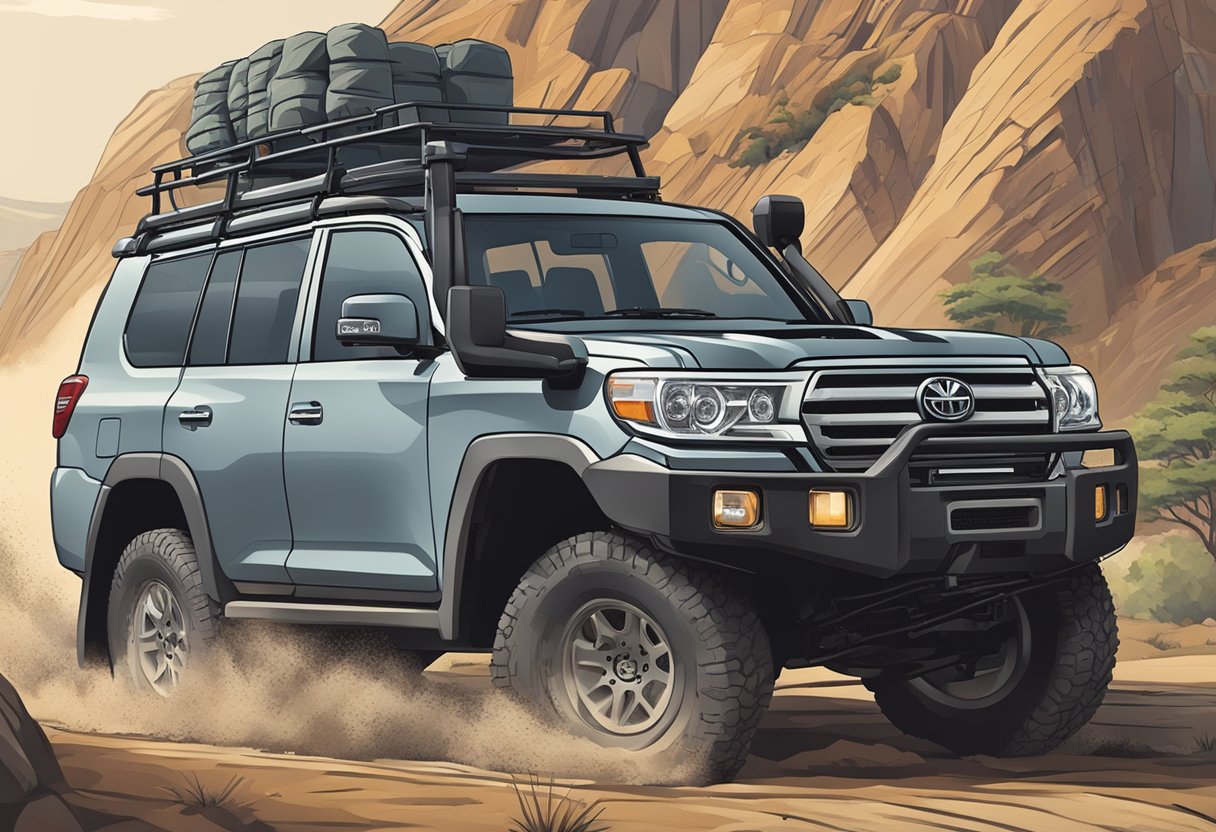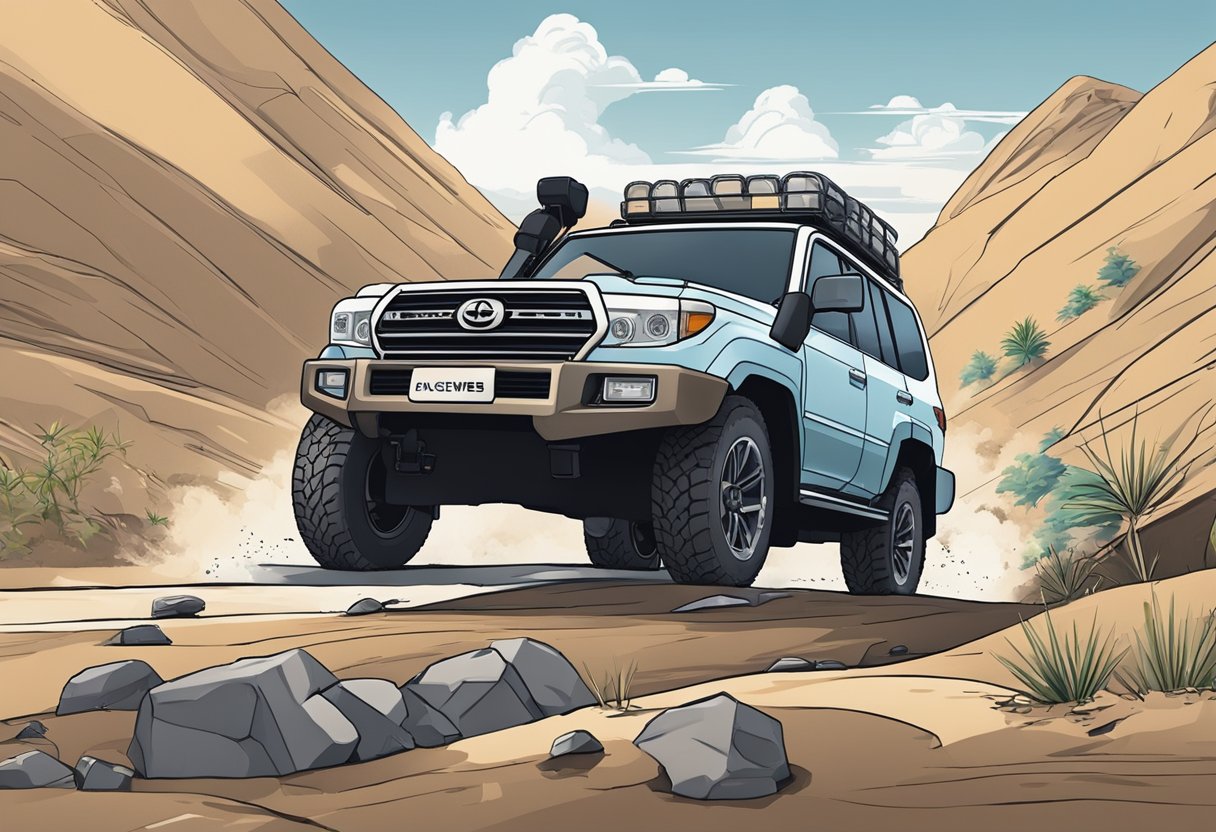*This post may contain affiliate links. As an Amazon Associate we earn from qualifying purchases.
Engaging the four-wheel drive system in a Toyota Land Cruiser is like unlocking the full potential of a burly adventurer eager to take on the wild. It allows drivers to conquer challenging terrain with confidence, transforming any off-road excursion into a gripping chapter of their travel diary. Navigating through rocky inclines, muddy trails, or sandy dunes demands a vehicle that can match the unpredictability of nature’s intricate mosaic, and activating 4WD on a Land Cruiser is akin to equipping it with superpowers suited for the rough and tumble of the outdoor landscape.

When the pavement ends and the dirt roads beckon, knowing how to switch your Land Cruiser into four-wheel drive can mean the difference between a legendary journey and just spinning your wheels. It’s a bit like the transition from mild-mannered citizen to caped crusader, where you go from city cruising to mastering nature’s labyrinth. With the right technique, drivers can effortlessly tap into the beast mode of their vehicle, ensuring that each voyage is not just a drive, but an epic tale of man and machine versus the wild.
Key Takeaways
- Activating 4WD empowers the Land Cruiser for diverse off-road challenges.
- Proper technique ensures seamless transition to four-wheel drive mode.
- Exiting 4WD requires attention to detail for a smooth return to normal driving.
Prepping for the 4WD Adventure

Venturing into rough terrain demands more than just a sense of adventure and a playlist full of travel tunes. It requires a fundamental understanding of the mechanical comrades under the hood and a keen eye on the vital fluids that keep the Land Cruiser’s heartbeat regular.
Understanding Your 4×4’s Anatomy
Before one embarks on a journey that would make Indiana Jones envious, it is indispensable to get acquainted with the machinery that transforms a sleek city cruiser into a fearless trail conqueror. Your Toyota Land Cruiser comes equipped with a robust:
- Engine that roars like a lion at the twist of a key,
- Transfer case which acts as the command center for power distribution,
- Transmission (Trans), the trusty sidekick of the engine which wrangles the RPMs to keep them in check,
- Center differential that ensures the wheels don’t throw a tantrum by spinning at their own whimsical rates,
- Front and Rear differentials that prevent the tires from writing their own circle of life while turning, and
- Durable Axles that bear the grunt of the terrain, whether it’s as craggy as a crocodile’s back or as slippery as an eel.
But before one becomes a swashbuckler of dirt and gravel, it’s imperative to thumb through that sacred tome, the owner’s manual (hidden within the glove compartment), to comprehend the limits of your Land Cruiser’s capabilities. Locate the VIN (Vehicle Identification Number) often nestled on the dashboard, because like a cookie, it’s where all the tasty informational crumbs are.
Is Your Land Cruiser Thirsty? Check the Fluids
A Land Cruiser’s thirst isn’t just for adventure, but also the lifeblood that keeps its parts cool and lubricated. Here’s a no-tears checklist:
- Whip out that dipstick and inspect the engine oil level because no one likes an engine that coughs and wheezes.
- Peek at the transmission fluid with its own dipstick (yes, it’s a thing), ensuring it’s full and not feeling blue (or any strange color for that matter).
- Glance at the differentials and the transfer case, verifying their fluid levels are up to the brim to avoid metal on metal screech-fests.
- And let’s not forget those tyres – pressure them right, or they might sulk, affecting your Land Cruiser’s stability and ability to strut its stuff on the terrain runway.
With all but a nod to the engine, a pat on the axles, and a solemn pledge to the differentials, the Land Cruiser is primed for an off-road escapade that rivals the plot twists of a daytime soap opera.
Engaging 4WD Like a Pro
https://www.youtube.com/watch?v=7AuYNBSO32w&embed=true
Mastering the art of switching to four-wheel drive ensures one’s vehicle is ready for a more stable and powerful driving experience off the beaten track. Whether tackling slippery slopes or climbing rocky terrains, understanding how and when to shift to 4WD is crucial.
The Great 2H to 4H Shift
Before a driver contemplates showing a mountain who’s boss, they must know the magic move: transitioning from 2H to 4H. This is the go-to mode for those slippery yet not panic-worthy conditions. On the fly, whilst in motion, the audacious driver can switch to 4H—no tiptoeing around necessary!
- At speeds below 50-60 mph (80-100 km/h), one can seamlessly shift to 4H without stopping the chariot.
- It’s important to ensure the automatic transmission is in drive or the manual transmission is in gear, not neutral.
When to Hit the Low Range Button
For moments when the path less traveled looks intimidatingly rugged, 4L is the hero one summons. Accessing the low range, or 4L, requires a stop-and-shift ritual.
- Halt the steed: Bring the beast to a complete stop and slip the transmission into neutral—automatic or manual, both need this breather.
- Shift with gravitas: Only then, with a “no hill too steep” mindset, does one dial into 4L with a firm twist, a knight choosing their best sword from the arsenal.
This is the stuff of legends, only to be invoked when the journey slows, and traction is the line between a tale of victory and a comedy of errors. Low speed four-wheel drive is perfect for climbing feats and when the trail is more treacherous than a dragon’s dental check-up.
Remember, engaging 4WD is a skill as important as the tales of valiant off-road adventurers. Equip oneself with this knowledge, and one may yet become the stuff of legend—or at least get through a muddy patch without looking like a court jester.
Mastering Various Terrains
https://www.youtube.com/watch?v=6W__dAOnERM&embed=true
When they hit the great outdoors, Land Cruiser commanders need to know their trusty steel steed like the back of their hand—especially when it comes to the dark arts of four-wheel drive. Whether it’s a squelchy bog, a sandy dune, or a slippery slope that sends lesser vehicles into a tailspin, understanding how to harness the Land Cruiser’s power is key to not winding up as a stationary feature of the landscape.
Don’t Get Stuck in the Mud
When mud is the adversary, one must be sly. Engage the four-wheel drive control and consider the rear differential lock—mud’s mortal enemy. Unlike those who had to rely on old tales of “rocking” the car, Land Cruiser captains turn the dial to “4Lo”, and suddenly, it’s not just spinning wheels and a splatter show. Instead:
- Drive Slowly: Too much speed and drivers may become spectators of a mud ballet.
- Steady Torque: Maintain consistent torque and let the vehicle pull itself out of the muck.
Scaling Sandy Slopes
Beach-goers in burly Land Cruisers need not fear the sandy slopes. To avoid getting bogged down in beachfront embarrassment:
- Decrease Tire Pressure: Reduces the risk of becoming part of the landscape.
- Apply the Gas Judiciously: Sand demands respect; too much throttle, and you’re digging to China.
Taming the Slippery Snow
Snow can turn any terrain into a slip ‘n slide extravaganza. When the world turns frosty, it’s vital to keep calm and carry on with:
- Gentle Acceleration: Any rush, and wheels might just churn butter instead of grip.
- Use Low Gear to Descend: Never underestimate the power of a controlled descent on a steep grade.
The Land Cruiser isn’t just a vehicle—it’s a ticket to adventure, a beast with a dial for all seasons, and mastering its four-wheel drive is what separates the off-road scholars from the stuck-in-the-mud novices.
Leaving 4WD Land – Graceful Exit Strategies

Disengaging the 4-wheel drive (4WD) system on a Toyota Land Cruiser is like ending a dance with grace—you want to avoid stepping on any toes! Whether one’s been gallivanting through winter wonderlands or just making a quick jaunt over gravel, returning to 2WD ensures the drivetrain components don’t feel overworked. Here’s the low-down on leaving those four-wheel fun times behind, without causing a fuss:
- Place the vehicle in a complete stop, preferably on a level surface, and shift the transmission into Neutral (N).
- For vehicles with a manual selector: One should twist the 4WD knob or move the lever from 4×4 to 2WD (usually H4 to L2—or vice versa for those hardy souls venturing out of the land of low gears, L4).
- For vehicles with electronic selectors: Simply press the necessary button, usually indicated by 2WD or 4WD, to shift modes. It could be as easy as pushing a candy-like button.
If right after these steps the vehicle starts channeling its inner drama queen—lights flashing, beeping, the full diva performance—don’t panic! This is just the VSC off indicator having a moment. Typically, it’s just the SUV’s way to signal that it’s working on the switch.
Sometimes, the front wheels and the rear wheels need a moment to get their act together—after all, transitioning from four-wheel drive can be like telling a group of synchronized swimmers to freestyle. It’s all about coordination:
- Avoid turning sharply or doing doughnuts in parking lots to impress strangers—one’s not in an ice-capades show.
- Keep the engine and wheels properly lubricated; no one likes a squeaky performer.
- Gently apply the gas to ease into motion, avoiding unnecessary strain on the drivetrain components.
Bear in mind, doing this dance on dry pavement can really put a spin on the vehicle’s handling. The Land Cruiser’s not practicing for an event; it’s just trying to avoid an accident.
Remember, vehicles equipped with All-Wheel Drive (AWD) and a center differential are like the cousin who always stays chill at family gatherings. They can switch from AWD to 4WD without making a scene.
Always, always prioritize safety. Don’t let the vehicle’s center of gravity and enthusiasm cause a roll. After all, the purpose of exiting 4WD is to prevent a one-vehicle ballet.
In short, following these tips ensures components like the front and rear axles, drivetrain, and 4-wheel drive system stay as cool as a cucumber, and as happy as clams at high tide.
